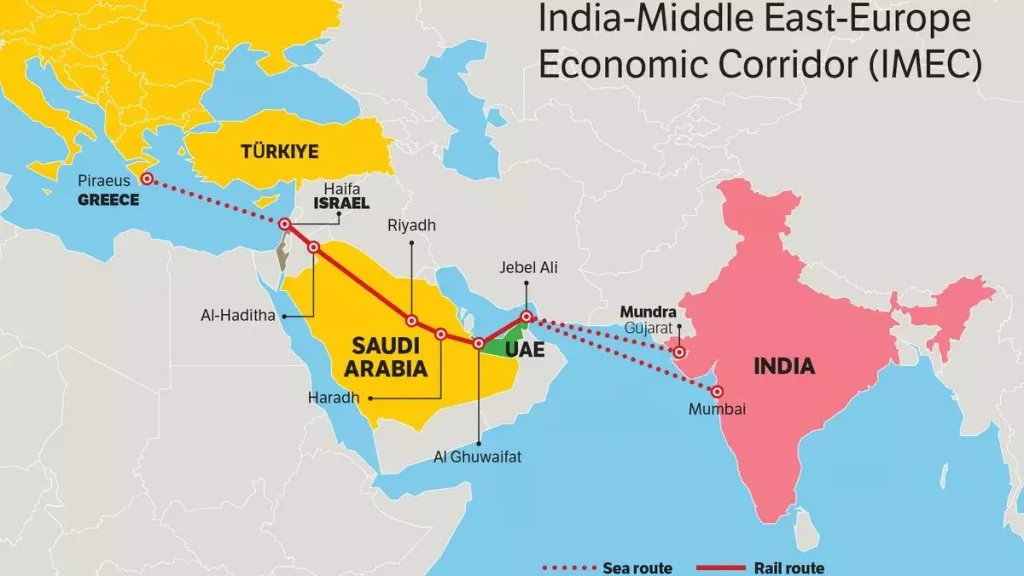Syllabus: GS3/International Relations
Context
- The Union Minister of Commerce & Industry stated that the India-Middle East-Europe Economic Corridor (IMEC) can add to India’s maritime security and faster movement of goods between Europe and Asia.
India-Middle East-Europe Economic Corridor (IMEC)
- Participants: During the Delhi G20 Summit, India, USA, UAE, Saudi Arabia, France, Germany, Italy and the European Union signed a Memorandum of Understanding (MoU) to establish the India-Middle East-Europe Economic Corridor.
- Objective: The corridor will encourage and provide impetus to economic development through enhanced connectivity and economic integration between Asia, West Asia, the Middle East and Europe.
Components
- The India-Middle East-Europe Economic Corridor will consist of two separate corridors,
- The East corridor connecting India to West Asia/Middle East and
- The Northern corridor connecting West Asia/Middle East to Europe.
- The project would involve the building of a railway line across the Arabian Peninsula through the United Arab Emirates and Saudi Arabia and develop shipping connectivity to India and Europe on either end of this corridor.
- The corridor could be further developed to transport energy through pipelines and data through an optical fiber link.
Ports Which are Part of IMEC
- India: Ports in Mundra (Gujarat), Kandla (Gujarat), and Jawaharlal Nehru Port Trust (Navi Mumbai).
- Europe: Piraeus in Greece, Messina in Southern Italy, and Marseille in France.
- Middle East: Ports include Fujairah, Jebel Ali, and Abu Dhabi in the UAE, as well as Dammam and Ras Al Khair ports in Saudi Arabia.
- Israel: Haifa port.
- Railway Line: The railway line will link Fujairah port in the UAE to Haifa port in Israel, passing through Saudi Arabia (Ghuwaifat and Haradh) and Jordan.

Maritime security for India
- The IMEC creates a robust and secure trade corridor across important maritime routes. It will give India a strategic role in patrolling and securing these areas
- India’s involvement ensures its critical maritime chokepoints, like the Arabian Sea and the Strait of Hormuz, are safeguarded.
- The collaboration between countries in the corridor will facilitate increased intelligence-sharing and joint maritime exercises.
- It will help India to monitor maritime threats like piracy, trafficking, and terrorism, particularly in volatile zones like the Gulf of Aden or the Red Sea.
- As IMEC improves connectivity, India has an opportunity to expand its naval presence in strategic ports within the Middle East and Eastern Mediterranean.
- This bolsters India’s power projection capability and ensures a protective watch over its trade routes.
- IMEC will ensure India that the strategic Indian Ocean region does not become dominated by Chinese investments, thereby preserving its maritime dominance and reducing external threats.
Other Opportunities for India
- Bypassing Pakistan: IMEC breaks Pakistan’s veto over India’s overland connectivity to the West. Since the 1990s, India has sought various trans-regional connectivity projects with Pakistan.
- But Pakistan was adamant in its refusal to let India gain access to land-locked Afghanistan and Central Asia.
- Indo-US collaboration in the Middle East: This project has broken the myth that India and the United States might work together in the Indo-Pacific but not in the Middle East.
Hurdle before IMEC
- The Israel-Palestine conflict has put a pause on the normalization of Arab-Israel relations which is a key element of the multi-nation initiative.
- Vulnerability of the Strait of Hormuz: The entire trade of the IMEC architecture flows through the Strait of Hormuz and with Iran’s proximity and control over the strait, the risk of disruptions remain very high.
- The security challenges in the region have made other partners reluctant to invest in the project.
Way Forward
- The geopolitical concerns need to be managed by striking a delicate balance in accommodating the geopolitical interests of the participating nations and addressing potential political sensitivities.
- There is also a need to maintain the required security apparatus as the project passes through certain unstable regions of the world.
Source: AIR
Previous article
News In Short-06-09-2024
Next article
Vishvasya-Blockchain Technology Stack